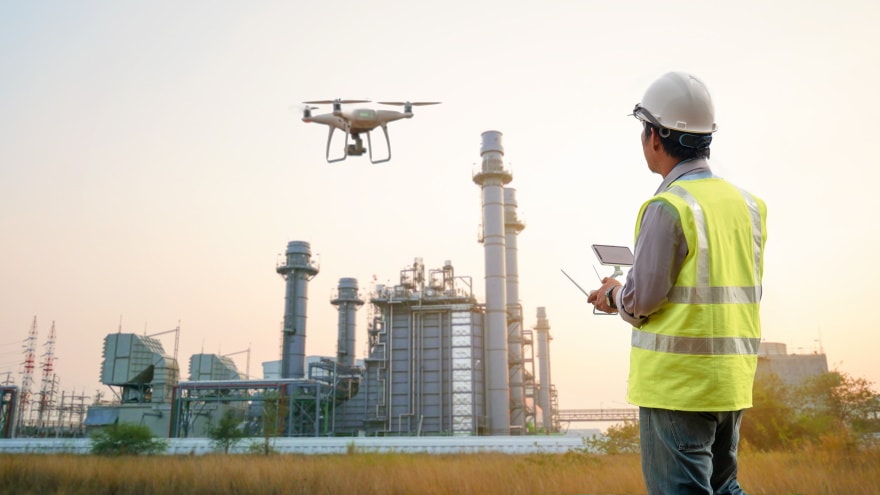How to Spot a Drone at Night: Understanding Drone Basics
Last Updated on

Between satellites, planes, and stars, the night sky can be a busy place!
But how can you tell the difference between all those different night objects and a drone? To the untrained eye, it can be hard to spot the difference — and easy to write it off as a UFO! But once you know what you are looking for, identifying a drone flying around at night is easier than you might think!

How Do You Tell If It’s a Drone at Night?
While it’s not guaranteed that drones have lights, most hobbyist drones will have a few navigation lights, especially higher-end models. If you’re trying to track down a drone at night, one of the easiest ways is to look for its lights.
Drone lights are LEDs, and they usually blink white, green, or red. In fact, if a drone is flying at night, the code of federal regulations, section 107.29, requires it to have anti-collision lights. So, if you do spot a drone flying at night without lights, it’s breaking federal law.
Once you spot the lights, you need to determine whether it’s a drone or simply a star, plane, or another aerial object. The easiest way to do this is to keep an eye on the light. If it changes direction or is moving much faster than anything else in the sky, there is a good chance that it’s a drone.
Planes can’t change direction as rapidly as a drone can. Also, most drones have more than one light, which helps you narrow it down further.
Drones don’t fly as high as planes, which means they tend to look like they’re moving quicker. In fact, drones can’t legally fly above 400 feet, while planes can be more than 30,000 feet in the air!
Finally, you want to look for something that doesn’t move along the same arc as everything else in the sky. If you’re seeing a star or even the International Space Station, it will have an arced trajectory in the sky. Drones don’t have this arc, making them stand out a bit compared to natural objects.

Do Drones Have Night Vision?
While you might be able to find a few drones with night-vision capability, most don’t have it. Still, the cameras that they come equipped with generally are high enough quality that they can take usable photos and video footage, even at night.
So, if you’re wondering if a drone can see you if it’s nighttime, chances are that it can.
Can Hobbyists Fly Drones at Night?
Yes! While rules have only recently changed to allow commercial drone pilots to fly at night if they achieve the right license, there have never been any federal restrictions against hobbyists flying their drones at night.
However, there may be local restrictions preventing people from flying over specific areas at certain times, so it’s always best to track down any rules and regulations that your local area has on drone operations for more specific guidance.
Finally, while hobbyists can usually fly their drones at night, they are required to have anti-collision lights, and there are often local restrictions against flying drones over residential areas or lingering over residential properties. Once again, check your local laws and regulations regarding drone use.

Are Drones Allowed Over My House?
This is a big gray area, and the restrictions are going to be different depending on your exact location. For instance, if you’re in California, flying drones over private property is completely illegal if there are any videos or photos and is considered trespassing.
But for states like Tennessee, it’s usually a civil matter, not a criminal one. That means you still might face penalties for flying drones over private property, but it’s not as easy for them to come after you.
If you’re considering flying drones over private property that isn’t your own, you probably shouldn’t. Still, if a company like Amazon flies an unmanned drone over your property, chances are that there’s nothing you can do because they’re not capturing any images.

Conclusion
Unless the drone that you’re trying to spot is flying illegally without anti-collision lights at night, they’re typically relatively easy to spot. Look for flashing lights that are changing directions or moving quickly — there’s a good chance that it’s a drone!
If you are worried about drones flying in areas that they shouldn’t, consult with your local laws and regulations. If they’re breaking a rule or law, record the infraction and get local law enforcement involved.
Related Read:
- How Far Can a Drone Fly? The Impressive Answer!
- 10 Best Night Vision Binoculars – Reviews & Top Picks
Featured Image Credit: Halfpoint, Shutterstock
About the Author Robert Sparks
Robert’s obsession with all things optical started early in life, when his optician father would bring home prototypes for Robert to play with. Nowadays, Robert is dedicated to helping others find the right optics for their needs. His hobbies include astronomy, astrophysics, and model building. Originally from Newark, NJ, he resides in Santa Fe, New Mexico, where the nighttime skies are filled with glittering stars.
Related Articles:
How to Clean a Refractor Telescope: Step-by-Step Guide
How to Clean a Telescope Eyepiece: Step-by-Step Guide
How to Clean a Rifle Scope: 8 Expert Tips
Monocular vs Telescope: Differences Explained (With Pictures)
What Is a Monocular Used For? 8 Common Functions
How to Clean a Telescope Mirror: 8 Expert Tips
Brightfield vs Phase Contrast Microscopy: The Differences Explained
SkyCamHD Drone Review: Pros, Cons, FAQ, & Verdict
